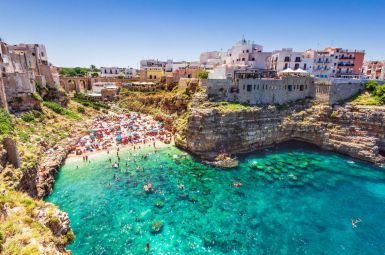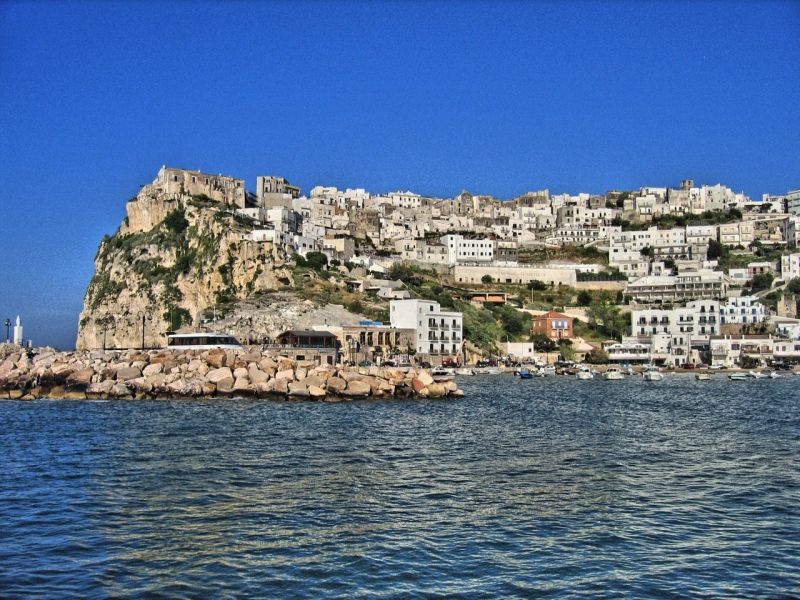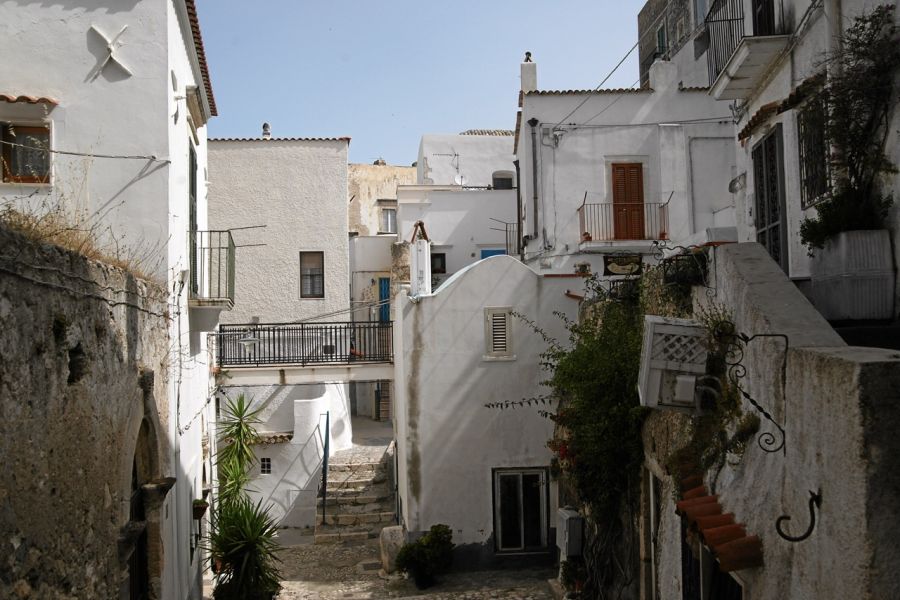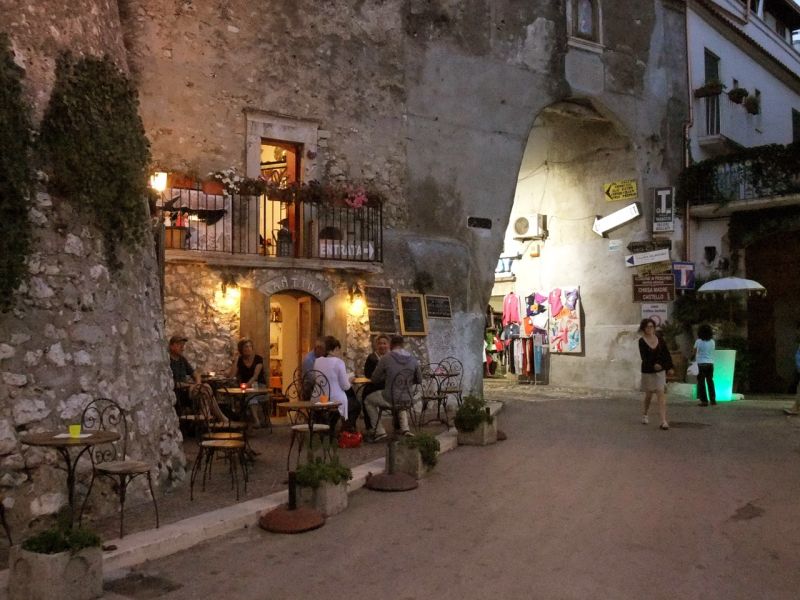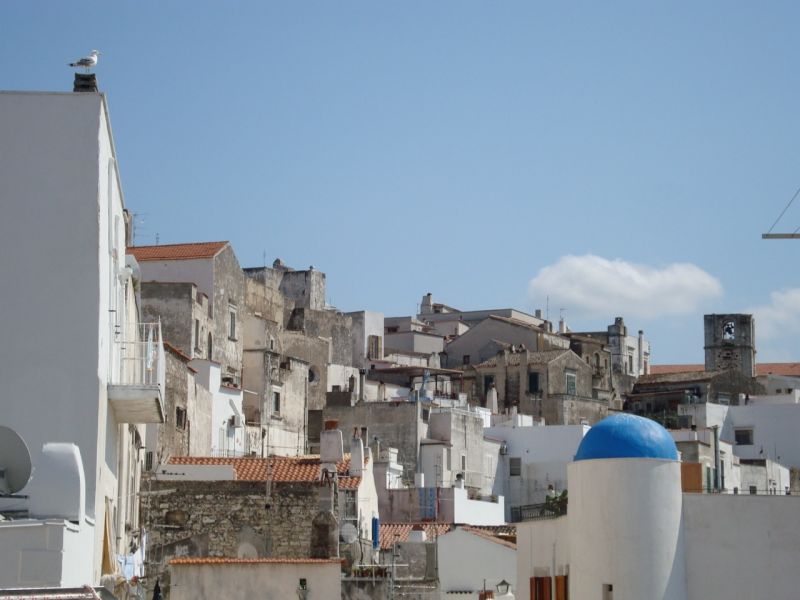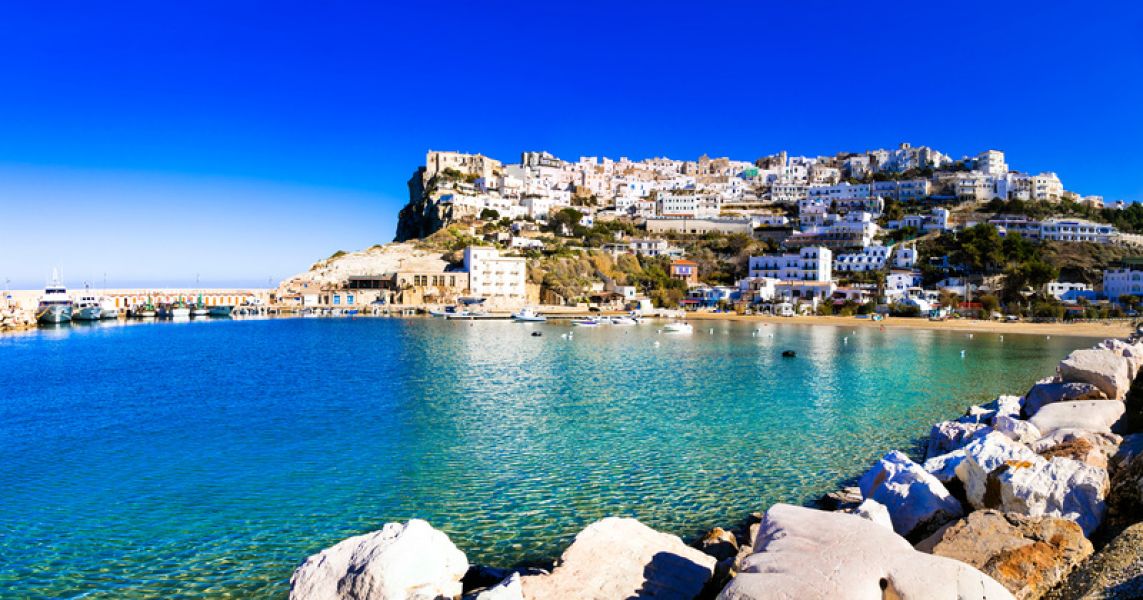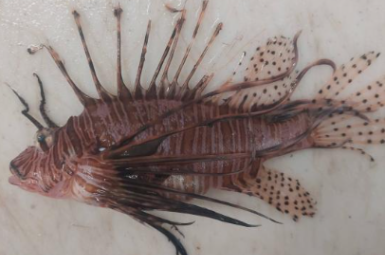
Il Borgo di Peschici
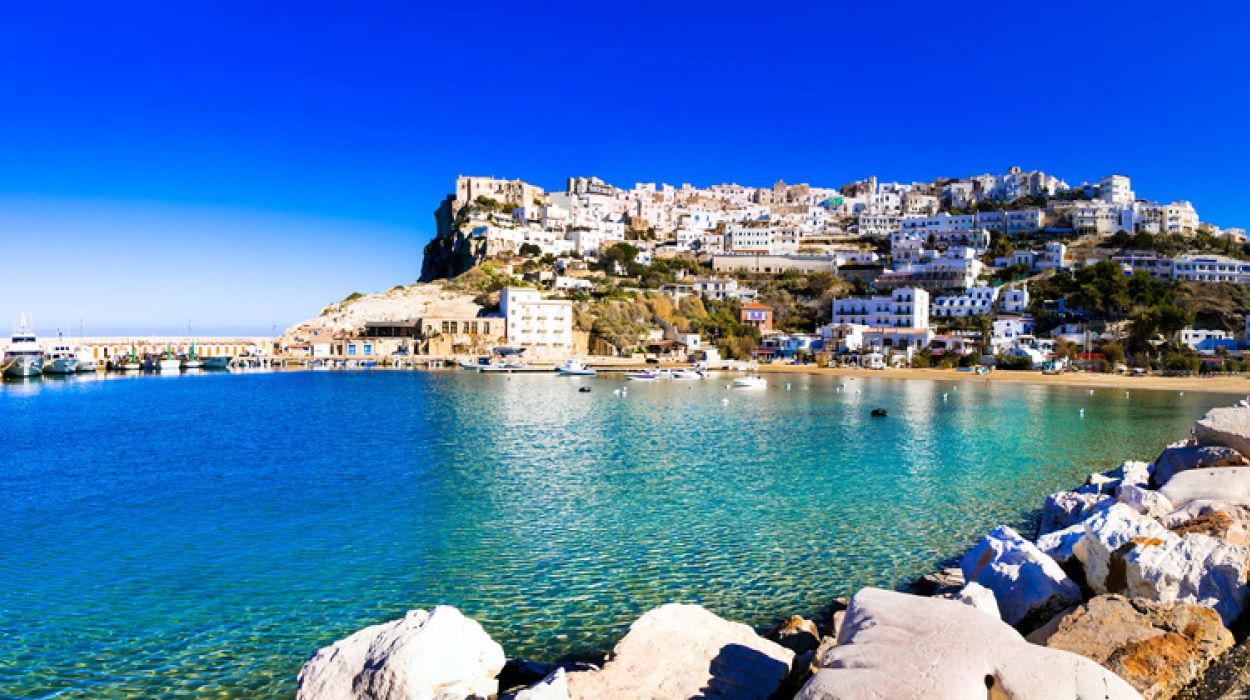
Il Borgo d’Italia
tutto da scoprire ed esplorare
Monumenti
Storia
Peschici è un piccolo borgo che si trova alle pendici del Gargano, dall’alto del suo promontorio strizza l’occhiolino ad alte scogliere e a baie dalle spiagge dorate. La vicinanza al mare ha portato questo territorio ad essere abitato fin dall’antichità remota ma per lo stesso motivo la zona è stata più volte attaccata e depredata da barbari e saraceni.
Per far fronte a quest’emergenza l’imperatore Ottone I di Sassonia inviò nel 970 d.C gli Schiavoni, una popolazione di origine slava che scacciò i turchi e fondò Pesclizio. Queste genti giunte dai Balcani restarono sul territorio per diversi secoli, riuscendo ad integrarsi perfettamente con la popolazione locale e lasciando a questa terra un po’ della propria lingua e della propria cultura.
Con l’avvento del feudalesimo, nel 1154 il feudo di Peschici passò nelle mani della contea di Lesina e iniziò così il suo peregrinare per casate e contee.
L’arrivo degli svevi nel meridione portò un periodo buio a Peschici, che subì un pesante attaccò da parte delle truppe inviate da Papa Gregorio IX contro Federico di Svevia. Grazie allo spirito di rivalsa del popolo la città è stata ricostruita e con l’arrivo degli angioini si è dotata anche di una fortezza e di numerose torri d’avvistamento lungo la costa.
Per gran parte della sua storia il Gargano, e con esso anche Peschici, ha vissuto in un isolamento che è terminato solo tra la fine dell’XIX e gli inizi del XX secolo, quando furono costruite la strada circum garganica e la ferrovia, inoltre venne ultimato l’acquedotto pugliese.
Nonostante questo, per gran parte del secolo scorso questo territorio ha conosciuto una forte ondata di emigrazione verso la Svizzera e il nord Italia. Solo negli ultimi decenni, grazie alla spinta dell’economia turistica questo processo si è notevolmente attenuato e Peschici sta riuscendo ad avere l’attenzione che merita da tempo
Castello medievale di Peschici
Il castello di Peschici sembra essere diventato un tutt’uno con la roccia, e bisogna guardare attentamente per capire dove inizino e dove finiscano le sue mura. Se fosse una persona diremmo che è un uomo burbero e solitario e si trascina addosso dopo secoli l’aspetto austero di chi è nato per difendersi.
Il castello di Peschici, infatti, è stato costruito per difendere la città dalle incursioni dei pirati saraceni, che sul finire del 900 asserragliavano il meridione. La sua costruzione originaria risale al 970 d.C, ma l’assedio delle truppe veneziane inviate da Gregorio IX l’hanno portato alla completa distruzione. Sui suoi resti Federico II ha edificato l’attuale castello, una fortezza priva di qualsiasi decoro ma inespugnabile, che si sporge dall’alto di un suggestivo costone roccioso a picco sul mare. Le mura spesse del castello lasciano trapelare la grande paura che Peschici aveva di essere nuovamente assediata. Tanta era grande la paura che la fortezza era dotata di un pozzo e di un silos per il frumento per poter essere autosufficiente in caso di attacco esterno.
Oggi il castello di Peschici è proprietà privata, dopo il suo recente restauro è stato reso fruibile anche al pubblico esterno.
Curiosità
I Trabucchi
Si racconta che si trovino sulla costa fin dai tempi dei fenici e sembra un mistero come abbiano fatto a giungere fino a noi. I Trabucchi infatti sono costruzioni che sembrano fragili ma nascondo un animo forte. Sono realizzati con sottili tronchi di Pino d’Aleppo, che continuano a resistere a vento e pioggia, ma soprattutto alla salsedine che li copre e li corrode. I trabucchi sono sistemi di pesca realizzati con pali di legno conficcati nelle scogliere, hanno braccia che sorreggono un sistema di fili e carrucole pronte a calare in mare le loro reti a maglie strette.
Per lungo tempo i trabucchi sono stati abbandonati, oggi invece è stato riconosciuto il grande valore di queste singolari costruzioni e vengono tutelati come patrimonio monumentale del Parco Nazionale del Gargano. Alcuni Trabucchi sono ancora in funzione e forniscono pesce fresco ad importanti ristoranti di Peschici e Vieste: gustare per credere.
Baia Zaiana
Peschici sembra uscita fuori da una cartolina dei Caraibi e sicuramente le sue spiagge finissime e il suo mare cristallino non ha nulla da invidiare alle località esotiche. Tra alte scogliere adatte ai tuffi dei più temerari ed insenature che abbelliscono panorami mozzafiato, si trovano anche baie e spiagge adatte a chi cerca relax, sole e mare. Chi poi non vuole rinunciare a tutte e tre queste caratteristiche, non può fare a meno di passare da Baia Zaiana. A pochi km da Peschici, questa baia dorata è circondata da un costone roccioso, dipinto dal verde dei boschi. È un piccolo gioiello della zona, che lascia incantati e sorpresi ma anche desiderosi di scoprirla fino in fondo.
Grottone di Manaccora, la grotta degli Dei
Quando il cristianesimo non esisteva e si adoravano divinità legate al mondo dei fenomeni naturali, un gruppo di uomini abitava la baia di Manaccora, precisamente una rientranza rocciosa che oggi è conosciuta da tutti come “La grotta degli Dei”.
Fin dall’età del Bronzo questa grotta è stata abitata e vissuta a pieno ed ancora oggi si trovano i resti delle popolazioni che sono passate da qui.
All’interno della grotta gli uomini che l’hanno abitata hanno utilizzato gli anfratti laterali per costruire ipogei in cui celebrare riti religiosi, legati soprattutto alla fertilità. In tempi successivi nella cavità si svolgeva anche la vita quotidiana, infatti sono stati ritrovati vasi e monili, oggetti per la lavorazione del metallo e dei tessuti e persino per la produzione di prodotti caseari.
Dagli oggetti abbandonati nella cavità, da alcune tombe e da altre testimonianze raccolte si è dedotto che in quel luogo viveva un gruppo di aristocratici guerrieri che era in stretto contatto con i popoli che si trovavano sull’altra sponda dell’Adriatico.
Oggi la Grotta degli Dei è affidata alla gestione dell’associazione culturale Ars Nova di Peschici, che è riuscita a ricreare un ambiente abitativo preistorico, composto da una rudimentale capanna e da utensili dell’epoca.
Santa Maria di Loreto, storia e tradizioni
Il mare dà e il mare prende, è sempre stato così fin dalla notte dei tempi. Lo sanno bene i pescatori e i marinai che solcano il mare, pregando di non incappare in tempeste e temporali. La forza della risacca ha portato a riva tanti naviganti grati al cielo e altrettante storie avventurose di devozione eterna. È legata ad una di queste il piccolo santuario della Madonna di Loreto, che si trova pochi passi fuori da Peschici. È una piccola cappella imbiancata a calce che un gruppo di marinai costruirono come voto alla Madonna, per averli salvati da una violenta tempesta.
Le pareti profumano di una fede autentica ed antica, perduta nei corridoi della storia e raccontata oggi a tutti dai piccoli manufatti marinari che decorano le pareti della chiesetta: remi, velieri ma anche piccoli oggetti a forma di barca.
A Peschici la Madonna di Loreto si festeggia il secondo lunedì dopo pasqua, quando in tanti si ritrovano vicino al santuario con in mano il loro cestino da picnic.
Personaggi
Peschici: L’Eredità di Fede e la Ricchezza Culturale del Borgo a Picco sul Mare
Volti e Spiriti: Le Personalità che Hanno Onorato la Storia di Peschici, Perla del Gargano
Peschici, con le sue case bianche abbarbicate sulla roccia e il suo affaccio spettacolare sull’Adriatico, è un borgo che vanta una storia antica, segnata da eventi e tradizioni che ne hanno plasmato l’identità. Sebbene non si annoveri una lunga lista di celebrità di risonanza globale nate nel dopoguerra, la sua storia è impreziosita da figure di rilievo nel contesto ecclesiastico e da legami significativi con il mondo della cultura.
1. Monsignor Domenico Umberto D’Ambrosio
- Pastore e Guida Spirituale: La figura di maggior rilievo nativa di Peschici è Monsignor Domenico Umberto D’Ambrosio (1941), un alto prelato che ha dedicato la sua vita alla Chiesa.
- Arcivescovo Emerito: Monsignor D’Ambrosio ha ricoperto importanti incarichi ecclesiastici, culminati nel suo ruolo di Arcivescovo Metropolita di Lecce, uno dei centri più significativi del Salento. La sua carriera è un esempio di come la fede e la dedizione nate nel piccolo borgo garganico abbiano portato a ricoprire ruoli di alta responsabilità nella gerarchia cattolica, rendendo onore alla sua città natale.
2. Il Legame con la Letteratura (Parco Letterario)
Peschici è stata un punto di incontro e ispirazione per importanti figure del mondo letterario, un patrimonio culturale che, sebbene non legato a nativi diretti, ne esalta il ruolo di musa:
- Incrocio di Intelletti: La storia locale ricorda che Peschici era un luogo di ritrovo per intellettuali di spicco come lo scrittore Giuseppe Ungaretti, il poeta e scrittore locale Petrucci di San Nicandro, e il grande artista pugliese Andrea Pazienza.
- Il Progetto del Parco Letterario: Il forte legame tra il borgo e questi autori ha ispirato l’iniziativa di istituire un “Parco Letterario” in loro nome, riconoscendo Peschici come un luogo che ha nutrito la loro creatività, elevandola a scenario di grande ispirazione artistica e narrativa.
3. I Fondatori e le Radici Storiche
La storia di Peschici è definita più dai suoi eventi fondativi e dalle dominazioni che da singole personalità celebri:
- Sueripolo e gli Schiavoni: Le origini del borgo, risalenti al 970 d.C., sono legate al condottiero slavo Sueripolo, capitano degli Schiavoni. Fu lui a scacciare i Saraceni dal Monte Gargano su ordine dell’Imperatore Ottone I. Sebbene non fosse nativo, la sua azione è fondamentale per la nascita e l’identità del borgo, che deve il suo nome, secondo alcune ipotesi, proprio a quel popolo slavo (Pessichis).
In sintesi, Peschici si distingue non solo per i suoi figli di spicco nel campo ecclesiastico, ma anche come crocevia culturale che ha saputo incantare e ispirare alcuni dei maggiori talenti della letteratura e dell’arte.
Ricette Tipiche
Certamente. Ecco un testo professionale sulle ricette tipiche di Peschici.
Peschici: Il Gusto Selvaggio e Autentico del Gargano in Tavola
Sapori a Picco sul Mare: L’Arte Culinaria di Peschici, tra Terra e Trabucchi
La cucina di Peschici, perla bianca incastonata sulla costa del Gargano, è un patrimonio gastronomico che riflette perfettamente l’equilibrio tra la ricchezza del Parco Nazionale del Gargano e la generosità del mare Adriatico. Le ricette peschiciane sono un inno alla semplicità degli ingredienti genuini, valorizzati dall’eccellente Olio Extra Vergine d’Oliva locale e dalle erbe selvatiche.
1. Piatti Iconici: Il Trionfo del Mare e della Pasta
- Pancotto con Verdure Selvagge: Espressione suprema della cucina contadina del Gargano. Il Pancotto è una sostanziosa zuppa a base di pane raffermo (spesso quello robusto di Monte Sant’Angelo), sbollentato e poi cotto con le verdure selvatiche raccolte nei campi circostanti, aglio, peperoncino e un abbondante filo di olio crudo. Un piatto che unisce gusto e recupero.
- Tiella di Riso, Patate e Cozze (Variante Garganica): Sebbene sia un classico pugliese, la Tiella a Peschici acquista un sapore unico grazie alla freschezza del pescato locale e alla qualità delle patate della terra rossa. Gli strati di riso, patate e cozze vengono cotti al forno lentamente in una teglia di terracotta, insaporiti da pomodorini, cipolla e pecorino grattugiato, creando una crosticina dorata irresistibile.
- Troccoli con Sugo di Seppia Ripiena: I Troccoli sono un formato di pasta fresca simile a spaghetti molto spessi, tipici dell’area di Foggia e Gargano. A Peschici si esaltano nel condimento con un ricco sugo di seppie ripiene (farcite con mollica di pane, formaggio, aglio e prezzemolo) o con frutti di mare freschissimi.
2. Lo Street Food e le Delizie del Borgo
- La Paposcia: Come nel vicino Vico del Gargano, anche a Peschici la Paposcia è un’istituzione dello street food. Questo pane allungato, cotto nel forno a legna e leggermente schiacciato, è la merenda perfetta. La versione peschiciana è spesso farcita semplicemente con olio EVO e sale, per assaporare appieno la qualità dell’impasto, oppure con salumi e formaggi locali.
- I Fichi Secchi Ripieni: Peschici e l’intero Gargano sono terre di fichi di eccellente qualità. Il frutto viene essiccato al sole e poi farcito con un cuore di mandorle tostate e scorza di agrumi, per poi essere infornato. Sono una prelibatezza tradizionale che racchiude i profumi estivi della macchia mediterranea.
3. I Dolci della Tradizione Festiva
- Cartellate al Vin Cotto: Dolce simbolo del Natale pugliese, le Cartellate sono una pasta sfoglia sottile lavorata a forma di rosa e fritta, poi immerse nel Vin Cotto (mosto cotto) caldo, che le rende brillanti e mielose. Rappresentano la gioia delle festività e sono immancabili sulle tavole peschiciane.
- Ostia Piena: Un dolce secco caratteristico dell’area, composto da due “ostie” che racchiudono un ripieno croccante a base di mandorle tostate, miele e talvolta frutta secca, offrendo un finale di pasto ricco e energetico, fedele alla tradizione dolciaria del Sud Italia.


